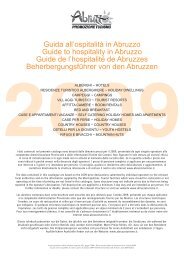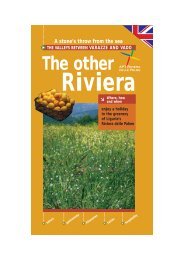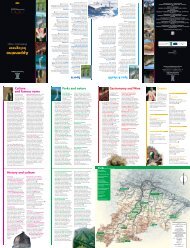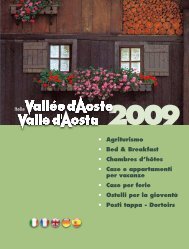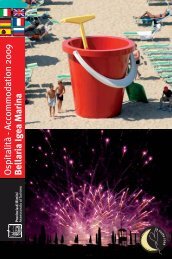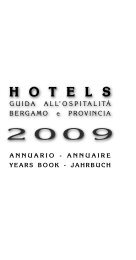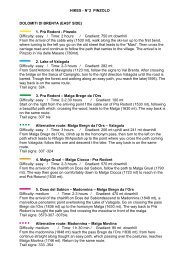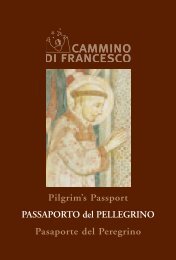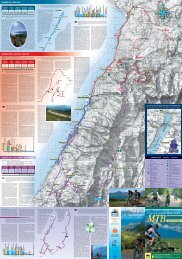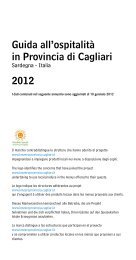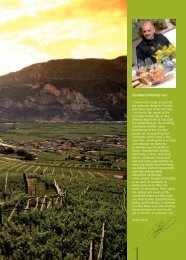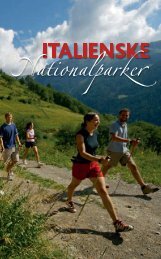Discover Padua and its surroundings.
Discover Padua and its surroundings.
Discover Padua and its surroundings.
You also want an ePaper? Increase the reach of your titles
YUMPU automatically turns print PDFs into web optimized ePapers that Google loves.
2647_05_C415_PADOVA_GB 17-05-2006 10:38 Pagina 16<br />
A province of waters.<br />
The first settlement of <strong>Padua</strong> arose around<br />
the 12 th century B.C. inside a wide bend of the river<br />
Medoacus, the actual river Brenta. Since then the history<br />
of <strong>Padua</strong> has been marked by waters. Already in the 1 st<br />
century A.D. the famous Roman historian, Titus Livius<br />
(or Livy), author of one of the more veritable versions<br />
of the history of the Roman Republic, narrated of the<br />
incredible skill of the <strong>Padua</strong>ns in navigation, when in the<br />
year 302 B.C. they defeated the fleet of the Spartan King<br />
Cleonimus. During the Roman age Patavium was one of<br />
the most thriving commerce centres of the Roman Empire.<br />
3 4<br />
1-3 <strong>Padua</strong>n waterways<br />
4 Canale Battaglia riverbank<br />
5 Onara Marsh<br />
6 Canoeing on the Bacchiglione River<br />
7 <strong>Padua</strong>, view of the waterway<br />
which flows around the ancient walls<br />
16<br />
2<br />
8 Riviera del Brenta, tourist navigation<br />
in front of Villa Giovannelli<br />
at Noventa Padovana<br />
9 <strong>Padua</strong>, Ognissanti Gate<br />
10 Battaglia Terme,<br />
Museum of River Navigation<br />
The great Greek historian <strong>and</strong> geographer Strabon wrote<br />
that Patavium was the most important town of the region<br />
<strong>and</strong> ancient chronicles report of the great number of wares<br />
that left <strong>its</strong> harbour towards Rome thus proving the presence<br />
of a flourishing <strong>and</strong> dynamic people <strong>and</strong> economy.<br />
The city thrived until the barbarian onslaughts <strong>and</strong><br />
the subsequent Langobard invasion, which took place from<br />
the fourth to the seventh century. Recovery was slow <strong>and</strong><br />
<strong>Padua</strong>’s great canal network played again a fundamental<br />
role, as it had an ever increasing strategic importance<br />
in the fights for the territorial supremacy. First during<br />
the Commune government <strong>and</strong> then during the Da Carrara<br />
Seigneury <strong>and</strong> the Venetian domination the excavations<br />
realized to control <strong>and</strong> exploit the waters led to the creation<br />
of a dense network of navigable canals, real <strong>and</strong> true<br />
“water motorways”. This network connected <strong>Padua</strong> with<br />
the surrounding territory <strong>and</strong> with all the most important<br />
towns of the Veneto region. During the four centuries<br />
of the Venetian domination waterways were used<br />
to transport an impressive quantity of wares <strong>and</strong> goods<br />
from the paduan territory to Venice <strong>and</strong> Venetian<br />
noblemen could easily navigate them to reach<br />
5<br />
1<br />
the Euganean Hills <strong>and</strong> the paduan countryside, where they<br />
erected their magnificent villas. Until the middle of the 20 th<br />
century <strong>Padua</strong>n waterways were sailed by all sort of boats:<br />
rafts, peote, burci, gondole, s<strong>and</strong>oli, padovane <strong>and</strong> burchielli,<br />
<strong>and</strong> were populated by fix <strong>and</strong> floating watermills.<br />
The Bacchiglione river, which in the past connected Vicenza<br />
with <strong>Padua</strong>, represents still today the primary water source<br />
for the city: <strong>its</strong> waters enter in <strong>Padua</strong> from the South <strong>and</strong><br />
flow along the Renaissance walls to the Ezzelino Castle.<br />
Here the Bacchiglione bifurcates: the link<br />
wing, called Tronco Maestro, flows<br />
8<br />
7<br />
downwards along<br />
the medieval walls<br />
to the old Carmine<br />
Basilica; the right<br />
wing, called Naviglio<br />
Interno, follows the<br />
internal side of the<br />
walls, flows through the<br />
city centre to the Porte<br />
Contarine, after which the Tronco<br />
Maestro <strong>and</strong> the Naviglio interno flow together <strong>and</strong> form<br />
the Piovego canal. In the last years a great programme<br />
of waterways recovering <strong>and</strong> restoring has given impulse<br />
to the tourist navigation along <strong>Padua</strong>n canals <strong>and</strong> rivers.<br />
9 10<br />
6<br />
The burci (or burchi), i.e.<br />
the typical Venetian barges,<br />
could easily moor anywhere<br />
along the river banks.<br />
In the Divine Comedy Dante<br />
reports that “As sometimes<br />
wherries lie upon the shore,<br />
That part are in the water,<br />
part on l<strong>and</strong>...”<br />
(Hell, canto XVII,<br />
vv. 19-20).<br />
The itineraries include the navigation along the internal<br />
canals with beautiful views on the walls, the Brenta River<br />
<strong>and</strong> <strong>its</strong> imposing villas, the Euganea Riviera with <strong>its</strong><br />
enchanting vegetation <strong>and</strong> historical sites, the way to the<br />
Venetian Lagoon. The story of river navigation <strong>and</strong> the life<br />
of the ‘barcari’ (boatmen)<br />
are widely narrated in the<br />
Museum of River<br />
Navigation in Battaglia<br />
Terme, which displays<br />
about four thous<strong>and</strong> pieces<br />
(boats, equipment, historic<br />
photos, old maps, books <strong>and</strong><br />
documents) housed in an<br />
historical little palace built<br />
in beautiful position at the<br />
confluence of two canals.<br />
17



